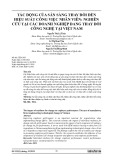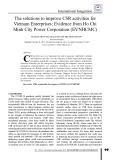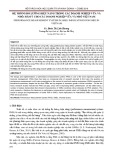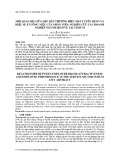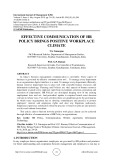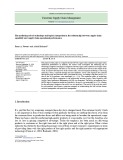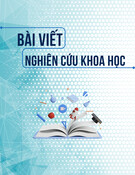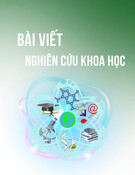No. 79 (2024) 116-122 I jdi.uef.edu.vn
The impact of servant leadership style on organizational innovation of tourism enterprises in Ho Chi Minh City
Nguyen Long Tram Anh*, Nguyen Ha Thanh Binh Van Hien University, Vietnam
K E Y W O R D S
A B S T R A C T
Servant leadership style, Organizational innovation, Organizational learning.
One of the main factors influencing an enterprise’s ability to succeed and gain a competitive advantage is organizational innovation. However, the relationship and mechanisms of action between servant leadership style and organizational innovation are comparatively understudied. The study examines the impact of servant leadership style on organizational innovation of tourism enterprises in Ho Chi Minh City through organizational learning. The study uses Structural equation modeling (SEM) to test the suitability of the model and research hypotheses with data collected from 257 managers of tourism enterprises in Ho Chi Minh City through purposive sampling method. Results show that servant leadership style has a positive impact on organizational innovation and organizational learning. In addition, the research also finds that organizational learning has a positive impact on organizational innovation. Besides, the study demonstrates the mediating role of organizational learning in the relationship between servant leadership style and organizational innovation.
1. Introduction
the organizational environment
With the emergence of the knowledge-based international the escalation of economy and is competition, growing more dynamic, complex and uncertain, which puts more pressure on organizational innovation and flexibility. Organizational innovation, which is essential for enterprises to obtain a competitive advantage, demands every person to actively expand their thinking and take the initiative to innovate in response to the constant changing market environment. An essential component influencing
organizational innovation is leadership (Ali, 2023). Because of their distinctive style of leadership, servant leaders have gained significant attention in the field of organizational management in recent years. Employee behavior can be more easily influenced by servant leaders that prioritize employee’s needs and growth, treat employees as friends and emphasize the importance of employees (Georges, 2023). Research has shown that new ideas are introduced into an organization through organizational learning (Karasneh, 2019). Employee’s ability to recognize opportunities, comprehend novel concepts and develop their creativity is enhanced by organizational
* Corresponding author. Email: anhnlt@vhu.edu.vn
https://doi.org/10.61602/jdi.2024.79.13 Received: 30-Aug-24; Revised: 26-Nov-24; Accepted: 27-Nov-24; Online: 06-Dec-24 ISSN (print): 1859-428X, ISSN (online): 2815-6234
116 Journal of Development and Integration, No. 79 (2024)
Nguyen Long Tram Anh and Nguyen Ha Thanh Binh
to
inclusive
leadership,
that allows employees thrive. Additionally, servant leaders emphasize bottom-up empowerment, enhancing employees’ self-assurance, judgment, and teamwork.
learning. Organizational learning helps to enhance innovation in enterprises (Salim & Sulaiman, 2011). The effect of several leadership styles, including transactional leadership, transformational leadership and authentic leadership, on organizational innovation has been studied in previous studies (Saqif & Iriani, 2023). However, there is still a gap of knowledge on the relationship between servant leadership style and organizational innovation. Furthermore, no research has been done on the impact of servant leadership style on organizational innovation through organizational learning, which is a crucial factor in fostering the innovation process in enterprises. The objective of this study is to analyze the impact of servant leadership style on organizational innovation of tourism enterprises in Ho Chi Minh City with the mediating role of organizational learning.
2. Literature review
encompasses
learning
techniques, servant
Organizational learning refers to the active process of knowledge exchange among members of an organization to help them learn new skills and knowledge (Karasneh, 2019). Organizational learning fosters personal development, boosts corporate commitment and enables the creation of creative competitive and adaptable tactics in the organization (Francisca et al., 2022). According to Salim and Sulaiman (2011), there are 4 types of organizational learning. Individual learning involves staff members seeking opportunities for skill development and training through resources such as books, webinars, online courses, certificate programs, and case studies. Group learning, also known as team learning, occurs through knowledge transfer and skill acquisition during group activities and social learning experiences, including job mentoring, lunch and learns, and other team-centric exercises. In this setting, group members engage in discussions, debates, and critiques by sharing personal knowledge and relating it to their tasks and responsibilities. Organizational learning opportunities available to the entire organization, such as upskill training programs, guest lectures, online learning platform subscriptions, and access to higher education. Finally, interorganizational learning takes place when two or more organizations collaborate to exchange knowledge and experiences, often facilitated by venture capitalists who bring together leaders from their portfolio companies to share insights and address common challenges.
technology for
innovation describes
Organizations must be innovative to thrive in the face of constant change in their organizational environments. An innovation can be a new plan or program, a new administrative system, the production process a new and a new product or service (Tambosi et al., 2020). Organizational the implementation of new ideas, procedures and methods that significantly enhance the way an enterprise operates (Ali, 2023). Organizational innovation can improve an organization’s efficacy and performance (Karasneh, 2019). Organizational innovation can be used to transform an organization, either in reaction to external or internal environmental changes or as a proactive measure to affect environment beforehand.
The foundation of servant leadership style is the notion that leaders should put the greater good first (Retno et al., 2020). Servant leaders prioritize the needs of their team and enterprise. Leader’s personal goals are not given priority. The goal of servant leadership style is to accomplish a vision by giving staff members a lot of support (Francisca et al., 2022). As a result, staff members are able to develop and learn while contributing their knowledge and perspectives. Instead of using control and destructive leadership leadership style is centered on establishing power and influence. Employee empowerment is a hallmark of servant leadership style (Georges, 2023). An employee’s drive and bravery to be more innovative and creative can be increased by servant leadership style. This occurs because servant leaders offer their staff a certain amount of ownership and control. Servant leadership style encourages greater dedication and involvement from the employees, bolsters the enterprise’s culture and reduces the voluntary turnover rate. According to Djoko and Peddy (2017), servant leaders focus on establishing the enterprise’s strategic direction and effectively communicating it to employees. They promote employee ownership and provide necessary support, ensuring that employees have the funds, time, expertise, and resources required to accomplish their work. Instead of giving detailed instructions on how to perform each task, they provide a framework
117
Journal of Development and Integration, No. 79 (2024)
Nguyen Long Tram Anh and Nguyen Ha Thanh Binh
By providing distinctive goods or services, enhancing operational effectiveness, and opening up new market niches, organizational innovation enables companies to stand out from their rivals. This can lead to a competitive advantage, which is essential for success in a market with intense competition. Organizational innovation can assist companies in streamlining their operations, cutting waste, and improving their procedures (Salim & Sulaiman, 2011). This can lead to higher productivity and efficiency, which in turn may result in lower expenses and more revenues. With the aid of organizational innovation, companies can produce goods and services that more successfully satisfy the demands of their customers. This can improve happiness, loyalty and retention of customers. Enterprises can increase their agility and adaptability to shifting market conditions and client demands by embracing organizational innovation (Georges, 2023). This can help enterprises react swiftly to new opportunities and challenge.
authority and desire to support staff in achieving professional achievement (Georges, 2023). One of a enterprise’s most valuable assets is its workforce. Leaders have challenges in retaining devoted and productive staff, boosting revenue and fostering an awareness of employee engagement. The foundation of servant leadership style is the idea that those leaders who are best at prioritizing their followers’ needs before their own are the ones who can inspire their followers the most. The definition of a servant leader is one that prioritizes enhancing the organizational morals, values and culture. Therefore, one of the elements that promotes organizational learning is leadership. Over the past few decades, a number of studies have examined the effects of various leadership philosophies and practices, including altruistic and transactional leadership, on organizational learning (Francisca et al., 2022). By examining companies in Pakistan’s profit-oriented service industry, Choudhary et al. (2013) demonstrated how servant leadership style impacts organizational learning and raises the possibility that organizational learning might be raised by attending to employees’ needs. Research on the ICT sector in Malaysia (Salim & Sulaiman, 2011), the manufacturing sector in Jordan (Karasneh, 2019), the telecom sector in Pakistan (Hussain et al., 2018) and the textile sector in Brazil (Tambosi et al., 2020) has found that organizational learning has a positive impact on organizational innovation. Besides, according to a study conducted on Ethiopian manufacturing and service sector companies, companies that are able to access information, employ competent workers, provide training and engage in R&D are more likely to innovate than their competitors (Daksa et al., 2018). Diah et al. (2014) demonstrated that servant leadership foster creativity and innovation in companies. In addition, Luxi and Huayu (2024) proved that self-efficacy mediates the relationship between servant leadership and and team innovation performance. Khattak et al. (2023) also showed that organization learning played the mediating role in the relationship between servant leadership, leader-member-exchange and innovative work behavior in the high-tech firms. Futhermore, according to Emilio et al. (2022), servant leaders promote radical innovation through organizational learning capability.
The research proposes the following hypotheses: H1: Servant leadership style has a positive impact
Servant leaders are defined as leaders with a comprehensive and altruistic perspective of the enterprise that centers on the needs and goals of subordinates, which sets them apart from other forms of leaders. Previous research has shown that servant leadership style is crucial in raising staff members’ levels of emotional commitment, job satisfaction, organizational trust and organizational citizenship (Djoko & Peddy, 2017). Previous research has also proved that a significant influencing factor in determining whether employees propose an innovation is their interpersonal risk assessment of the external environment, which includes the actions and reactions of their leaders (Ali, 2023). Leadership- member exchange theory states that employees look up to the work values of their leaders as role models (Saqif & Iriani, 2023). Additionally, the attitudes and behaviors of leaders greatly influence the attitudes and behaviors of their subordinates. When managers are prepared to pay the cost of support and help to their employees, those staff members will likewise act in a way that returns the favor. Employee trust is bolstered in enterprises of servant leaders who prioritize their needs and put their staff’s needs first. Servant leaders also encourage innovation by encouraging their staff to test new ideas and approaches to solving problems at work. Therefore, servant leadership style has the positive impact on organizational innovation because of its focus on employee connection, awareness of emotional and mood changes, willingness to delegate
on organizational learning.
118 Journal of Development and Integration, No. 79 (2024)
Nguyen Long Tram Anh and Nguyen Ha Thanh Binh
H4
Organizational learning
H3
H1
Servant leadership
Organizational innovation
H2
Figure 1. Conceptual framework
Table 1. Summary of the constructs
Constructs Sources
(1) Servant leadership style (SL) (2) Organizational learning (OL) (3) Organizational innovation (OI) Georges (2023) Francisca et al. (2022) Ali (2023)
H2: Servant leadership style has a positive impact
on organizational innovation.
H3: Organizational learning has a positive impact
on organizational innovation. H4: Organizational
learning mediates
the relationship between servant leadership style and organizational innovation.
The proposed research model is as Figure 1.
3. Methodology
considerations will be strictly adhered to, including obtaining informed consent and ensuring participant confidentiality. The statistical technique which the research used is CB-SEM. CB-SEM is particularly suitable for this research as it allows for the testing of complex relationships and the mediation effects of organizational learning. The reliability of the scales will be assessed using Cronbach’s Alpha. Factor analysis will also be conducted to confirm the validity of the constructs. The results will be interpreted to determine the strength and significance of the relationships among servant leadership, organizational learning and innovation. Hypothesis testing will be performed to validate the proposed research model. The research model includes: (1) Servant leadership style, (2) Organizational learning and (3) Organizational innovation. The scales were from reaserch of Georges (2023), Francisca et al. (2022) and Ali (2023).
4. Results and discussions
4.1. Results
More than half of the respondents were male (55.6%). The majority of respondents aged between 46 to 60 (33.1 %) and 31 to 45 (27.6%). Among all the respondents, there were 74 managers from human resources department (28.8%) and 40 managers from finance department (15.6%), followed by 53 managers from marketing department (20.6%), 48 managers from sale department (18.7%) and 42 managers from operation department (16.3%).
The results in Table 2 show that the Cronbach’s
The research was conducted in Ho Chi Minh City with purposive sampling method. The selection criteria will focus on individuals in leadership positions, particularly managers known for practicing servant leadership. The study will target a diverse range of tourism enterprises, such as hotels, travel agencies and tour operators, to capture a wide array of perspectives. The survey will include Likert-scale questions designed to measure perceptions of servant leadership practices and their perceived impact on innovation. The research analyzed data surveyed from 257 managers of tourism enterprises in Ho Chi Minh City. The research ensures a diverse representation from various departments of tourism enterprises, including human resources, finance, marketing, sales and operations. Data collection will occur over a four- month period, from May to August 2024, utilizing the quantitative approaches. A structured questionnaire will be developed, incorporating validated scales to measure servant leadership, organizational learning, and innovation. The questionnaire will be distributed both online and in-person to maximize participation rates and ensure comprehensive data capture. Ethical
119
Journal of Development and Integration, No. 79 (2024)
Nguyen Long Tram Anh and Nguyen Ha Thanh Binh
Table 2. The constructs’ Cronbach’s Alpha coefficients, loadings, AVE, VIF and CR
Constructs Number of items Cronbach’s Alpha Loadings AVE CR VIF SL 8 0.781 0.65-0.71 0.683 0.773 1.485 OL 5 0.876 0.69-0.75 0.714 0.824 2.812 OI 7 0.842 0.73-0.82 0.752 0.781 2.381
Table 3. Correlations of constructs
Correlation Constructs SL HT OI SL 0.753 OL 0.415 0.686 OI 0.386 0.312 0.784
Figure 2. Results of structural equation model
index ranges from 1.485 to 2.812, which are much lower than the threshold of 5 (Hair et al., 2017). The results also show that the composite reliability (CR) ranges from 0.773 to 0.824, which are higher than 0.700 and does not exceed the threshold of 0.95 (Hair et al., 2017).
Alpha coefficient of the scales ranges from 0.781 to 0.876. Results show that all scales have Cronbach’s Alpha coefficient higher than 0.600, which shows that the scales used are reliable. Results in table 2 also show that the factor loadings of the factors range from 0.65 to 0.82 and are all greater than 0.5. The results also show that the AVE index ranges from 0.683 to 0.752, which are higher than the threshold of 0.5 (Hair et al., 2017). Results show that the VIF
The results in Table 3 show that the variables create distinct values compared to the remaining variables. It can be seen that the values in bold on the diagonal
120 Journal of Development and Integration, No. 79 (2024)
Nguyen Long Tram Anh and Nguyen Ha Thanh Binh
Table 4. Hypothesis testing results
Hypothesis Coefficients (standardized) p-values Conclusions Paths H1 0.61 0.011 H1 is supported SL OL H2 0.68 0.018 H2 is supported SL OI H3 0.71 0.004 H3 is supported OL OI H4 0.43 0.002 H4 is supported SL OL OI
organizational innovation. The findings of this study are similar with the results of Emilio et al. (2020).
in Table 3 are larger than the values of other variables according to vertically as well as horizontally. This result meets the standards of Hair et al. (2017).
5. Conclusion and implications
The results of the structural equation modeling analysis in Figure 2 show that CMIN/DF = 2.417 < 5, meeting the requirement for model fit. Other indicators such as TLI = 0.947 > 0.9, CFI = 0.924 > 0.9, and RMSEA = 0.057 < 0.08 also meet the criteria. Therefore, it can be concluded that the model is suitable for the data.
The results in Table 4 show that hypothesis H1 is accepted with an impact level of β = 0.61 at p = 0.011. Therefore, servant leadership style has a positive impact on organizational learning. Besides, hypothesis H2 is accepted at p = 0.018 with an impact level of β = 0.68. This confirms that servant leadership style has a positive impact on organizational innovation. In addition, hypothesis H3 is also accepted at p = 0.004 with impact coefficient β = 0.71. This result shows that organizational learning has a positive impact on organizational innovation. Finally, hypothesis H4 is also accepted at p = 0.002 with impact coefficient β = 0.43. This result proves that organizational learning mediates the relationship between servant leadership style and organizational innovation.
4.2. Discussion
Research demonstrated that servant leadership style has a positive impact on organizational innovation. The results of this reasearch are similar with the findings of Ali (2023). Besides, research proved that servant leadership style has a positive impact on organizational learning. The findings of this study are similar with the results of Francisca et al. (2022). The research show that organizational learning has a positive impact on organizational innovation. The results of this reasearch are similar with the findings of Karasneh (2019). In addition, the research also shows the mediating role of organizational learning in the relationship between servant leadership style and
To enhance servant leadership style so as to improve organizational innovation of tourism enterprises in Ho Chi Minh City, enterprises should choose leaders who exhibit the essential qualities of a servant leader, actively seek out mentoring and training opportunities to support the competency development of servant leaders, cultivate an innovative environment and embody the values and standards of the team to encourage creativity among staff, reward staff who are selfless, generous, and supportive to meet the needs of others, decentralize decision-making to reduce power disparities wherever possible and create an environment that supports staff’s growth. Besides, leaders have to balance empowerment and accountability. While shared decision-making and empowerment are key components of servant leadership style, it’s important to strike a balance between offering employees freedom and holding them responsible for their actions. Leaders need to set clear expectations, monitor development on a regular basis and offer assistance and constructive criticism. Additionally, conflict management is a need for leaders. A servant leader’s role is to encourage open communication and foster an atmosphere where team members feel free to express their opinions. This could result in disagreements and sporadic confrontations. When disagreements emerge, leaders need to resolve them quickly and fairly while concentrating on coming up with solutions that will benefit the whole enterprise. Furthermore, servant leaders need to be flexible. Change is inevitable. For the enterprise to successfully adapt to change and overcome obstacles, servant leaders need to possess resilience and adaptability. Servant leaders should promote a growth mentality and a culture that values learning, innovation and continuous progress.
121
Journal of Development and Integration, No. 79 (2024)
Nguyen Long Tram Anh and Nguyen Ha Thanh Binh
The role of organizational learning capability. Harvard Deusto Business Research, 9(1), 53–68. DOI: https://doi. org/10.3926/hdbr.264
on Manufacturing
Francisca, S. G., Sahala, B. P., Tatang, I. S., Srinita, S., Isyak, M., & Agustinus, P. I. (2022). The Effect of Transformational Leadership, Servant Leadership, and Organizational Industry Performance. Learning Frontiers in Psychology, 13. DOI: https://doi.org/10.3389/ fpsyg.2022.895361
Georges, Y. M. (2023). The Role of Servant Leadership Style in Improving Innovation in Higher Education Institutions. International Journal of Professional Enterprise Review, 8(9). DOI: https://doi.org/10.26668/businessreview/2023. v8i9.1787
Interdisciplinary
Journal
of
Hair, Jr. J. F., Hult, G. T. M., Ringle, C. M., & Sarstedt, M. (2017). A primer on partial least squares structural equation modeling (PLS-SEM) (2nd ed.). USA: Sage Publications. Karasneh, A. A. F. (2019). Reinforcing innovation through knowledge management: mediating role of organizational Information, learning. Knowledge, and Management, 14, 235-252. DOI: https://doi. org/10.1177/21582440231212267
Khattak, S. I., Khan, M. A., Ali, M. I., Khan, H. G. I., & Saeed, I. (2023). Relationship Between Servant Leadership, Leader- Member-Exchange, Organization Learning and Innovative Work Behavior: Evidence from High-Tech Firms. SAGE Open, 1-13. DOI: https://doi.org/10.1177/21582440231212267 Luxi, R. & Huayu, S. (2024). The relationship between servant leadership and team innovation performance: Mediating effect of self-efficacy. Heliyon, 10(6). DOI: https://doi. org/10.1016/j.heliyon.2024.e27723
Retno, P. S., Margono, S., Surachman, & Dodi, W. I. (2020). Servant Leadership Characteristics, Organisational Commitment, Followers’ Trust, Employees’ Performance Outcomes: A Literature Review. European Research Studies, 902–911. DOI: https://doi.org/10.35808/ersj/1722
The research show that organizational learning has a positive impact on organizational innovation. In addition, the research also shows the mediating role of organizational learning in the relationship between servant leadership style and organizational innovation. Therefore, to improve organizational learning in order to enhance organizational innovation of tourism enterprises in Ho Chi Minh City, enterprises should provide learning based on how employees learn. The majority of learning occurs during work. Therefore, enterprises need to enable workers to learn through practice while working. Organisations can adopt a formalised informal learning approach. Encouraging on-the-job learning through the provision of short, substantial and pertinent knowledge chunks is crucial to making this happen. In addition to providing conventional training, a leader’s duties also include giving staff members the necessary knowledge for practical application. While management is in charge of running an enterprise, experts are accountable for delivering tasks. Learning organizations act to recognize and value experts. Enterprises can help their experts in a number of ways, such as by offering technical career advancement or by providing time for individuals to further their education. An organization’s learning objectives should be reflected in its performance management and reward systems. Besides, organizations need to make knowledge and experts accessible. In addition to acknowledging experts, management ought to give them a platform to share their expertise when needed. Directories, internal forums and relevant events are necessary for enterprises.
REFERENCES
Salim, I. M. & Sulaiman, M. (2011). Organizational learning, innovation and performance: a study of Malaysian small and medium sized enterprises. International Journal of Enterprise and Management, 6(12), 118-125. DOI: https:// doi.org/ 10.5539/ijbm.v6n12p118
Ali, F. D. (2023). Nurturing Employee Engagement at Workplace and Organizational Innovation in Time of Crisis with Moderating Effect of Servant Leadership. Sage Open, 13(2). DOI: https://doi.org/10.1177/21582440231175150
Saqif, H. & Iriani, I. (2023). The Influence of Servant Leadership Style and Ethical Leadership on Organizational Change. Indonesian Journal of Contemporary Multidisciplinary Research, 2(5), 997–1012. DOI: https://doi.org/10.55927/ modern.v2i5.6210
Diah, T. Y., Sen, S., Giles, H., & Brian, C. (2014). Does servant leadership foster creativity and innovation? A multi-level mediation study of identification and prototypicality. Journal of Business Research, 67(7), 1395-1404. DOI: https://doi. org/10.1016/j.jbusres.2013.08.013
Tambosi, S. S., Gomes, G., & Amal, M. (2020). Organisational learning capability and innovation: study on companies in regional cluster. International Journal of located Innovation Management, 1-28. DOI: https://doi.org/ 10.1142/ S1363919620500577
Djoko, S. W. & Peddy, S. S. (2017). Building organizational performance: Analysis of transformational leadership style and servant leadership style on organization learning in Dki Jakarta government. International Journal of Advanced Research, 5(7), 1431–1444. DOI: https://doi.org/10.21474/ IJAR01/4855
Emilio, D., Francisco, F. M. B., Rafael, L. A. & Ricardo, C. (2020). How do servant leaders promote radical innovation?

